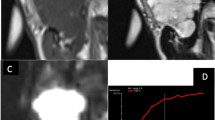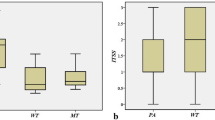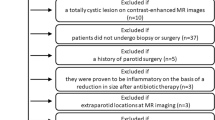Abstract
Purpose
To determine the value of non-enhanced MRI in combination with color Doppler flow imaging (CDFI) for differentiating malignant parotid tumors from benign ones.
Methods
This retrospective study analyzed 51 parotid gland lesions (39 benign and 12 malignant) in 51 patients who underwent preoperative CDFI as well as non-enhanced MRI including T1-weighted, T2-weighted, and diffusion-weighted imaging (DWI). Degrees of intratumor vascularity were categorized into four grades basing on CDFI findings. The relationships between the lesion and its adjacent external carotid artery and retromandibular vein were inspected on T1-weighted and T2-weighted images. Apparent diffusion coefficient (ADC) values were calculated from diffusion-weighted images, and were used to classify the parotid gland lesions with and without reference to the CDFI findings. The classification results were compared using the McNemar test. Sensitivity, specificity, and accuracy percentages were calculated when the non-enhanced MRI/CDFI findings were used to differentiate benign lesions from malignant ones.
Results
The diagnostic accuracy (96.1 vs 82.4%) was significantly improved when ADCs were used together with CDFI findings for classifying parotid gland lesions compared to when ADCs were used alone. Pleomorphic adenomas had the highest ADCs. The ADC thresholds were 1.425 × 10−3 mm2/s for differentiating pleomorphic adenomas from carcinomas, 0.999 × 10−3 mm2/s for differentiating pleomorphic adenomas from other benign lesions, and 0.590 × 10−3 mm2/s for differentiating benign lesions other than pleomorphic adenomas from lymphomas.
Conclusion
Combining CDFI with non-enhanced MRI can improve the diagnostic accuracy of MRI for classifying parotid gland lesions.





Similar content being viewed by others
References
Thompson L (2006) World Health Organization classification of tumours: pathology and genetics of head and neck tumours. Ear Nose Throat J 85(2):74
De Vincentiis M, Magliulo G, Soldo P, Manciocco V, Pagliuca G, Del Gaizo R, Gallo A (2005) Extended parotidectomy. Acta Otorhinolaryngol Ital 25(3):169–173
Lima RA, Tavares MR, Dias FL, Kligerman J, Nascimento MF, Barbosa MM, Cernea CR, Soares JR, Santos IC, Salviano S (2005) Clinical prognostic factors in malignant parotid gland tumors. Otolaryngol Head Neck Surg 133(5):702–708. https://doi.org/10.1016/j.otohns.2005.08.001
Cho HW, Kim J, Choi J, Choi HS, Kim ES, Kim SH, Choi EC (2011) Sonographically guided fine-needle aspiration biopsy of major salivary gland masses: a review of 245 cases. AJR Am J Roentgenol 196(5):1160–1163. https://doi.org/10.2214/AJR.10.4256
Chakrabarti S, Bera M, Bhattacharya PK, Chakrabarty D, Manna AK, Pathak S, Maiti K (2010) Study of salivary gland lesions with fine needle aspiration cytology and histopothology along with immunohistochemistry. J Indian Med Assoc 108(12):833–836
Jin GQ, Su DK, Xie D, Zhao W, Liu LD, Zhu XN (2011) Distinguishing benign from malignant parotid gland tumours: low-dose multi-phasic CT protocol with 5-min delay. Eur Radiol 21(8):1692–1698. https://doi.org/10.1007/s00330-011-2101-y
Yuan Y, Tang W, Tao X (2016) Parotid gland lesions: separate and combined diagnostic value of conventional MRI, diffusion-weighted imaging and dynamic contrast-enhanced MRI. Br J Radiol 89(1060):20150912. https://doi.org/10.1259/bjr.20150912
Sakamoto M, Iikubo M, Kojima I, Sasano T, Mugikura S, Murata T, Watanabe M, Shiga K, Ogawa T, Takahashi S (2014) Diagnostic value of capsule-like rim enhancement on magnetic resonance imaging for distinguishing malignant from benign parotid tumours. Int J Oral Maxillofac Surg 43(9):1035–1041. https://doi.org/10.1016/j.ijom.2014.03.008
Lechner Goyault J, Riehm S, Neuville A, Gentine A, Veillon F (2011) Interest of diffusion-weighted and gadolinium-enhanced dynamic MR sequences for the diagnosis of parotid gland tumors. J Neuroradiol J Neuroradiol 38(2):77–89. https://doi.org/10.1016/j.neurad.2009.10.005
Christe A, Waldherr C, Hallett R, Zbaeren P, Thoeny H (2011) MR imaging of parotid tumors: typical lesion characteristics in MR imaging improve discrimination between benign and malignant disease. AJNR Am J Neuroradiol 32(7):1202–1207. https://doi.org/10.3174/ajnr.A2520
Yabuuchi H, Matsuo Y, Kamitani T, Setoguchi T, Okafuji T, Soeda H, Sakai S, Hatakenaka M, Nakashima T, Oda Y, Honda H (2008) Parotid gland tumors: can addition of diffusion-weighted MR imaging to dynamic contrast-enhanced MR imaging improve diagnostic accuracy in characterization? Radiology 249(3):909–916. https://doi.org/10.1148/radiol.2493072045
Eida S, Ohki M, Sumi M, Yamada T, Nakamura T (2008) MR factor analysis: improved technology for the assessment of 2D dynamic structures of benign and malignant salivary gland tumors. J Magn Reson Imaging JMRI 27(6):1256–1262. https://doi.org/10.1002/jmri.21349
Strympl P, Kodaj M, Bakaj T, Kominek P, Starek I, Sisola I, Tomaskova H, Matousek P (2014) Color Doppler ultrasound in the pre-histological determination of the biological character of major salivary gland tumors. Biomedical papers of the Medical Faculty of the University Palacky. Olomouc Czechoslov 158(3):465–469. https://doi.org/10.5507/bp.2012.074
Bradley MJ, Durham LH, Lancer JM (2000) The role of colour flow Doppler in the investigation of the salivary gland tumour. Clin Radiol 55(10):759–762. https://doi.org/10.1053/crad.2000.0541
Schick S, Steiner E, Gahleitner A, Bohm P, Helbich T, Ba-Ssalamah A, Mostbeck G (1998) Differentiation of benign and malignant tumors of the parotid gland: value of pulsed Doppler and color Doppler sonography. Eur Radiol 8(8):1462–1467. https://doi.org/10.1007/s003300050576
Shellock FG, Kanal E (1999) Safety of magnetic resonance imaging contrast agents. J Magn Reson Imaging JMRI 10(3):477–484
Svaland MG, Lundby B, Kristoffersen DT (1994) Comparison of the safety of the standard dose and a higher dose of gadodiamide injection for MR imaging of the central nervous system. J Magn Reson Imaging JMRI 4(3):419–423
Martinoli C, Derchi LE, Solbiati L, Rizzatto G, Silvestri E, Giannoni M (1994) Color Doppler sonography of salivary glands. AJR Am J Roentgenol 163(4):933–941. https://doi.org/10.2214/ajr.163.4.8092039
Davachi B, Imanimoghaddam M, Majidi MR, Sahebalam A, Johari M, Javadian Langaroodi A, Shakeri MT (2014) The efficacy of magnetic resonance imaging and color Doppler ultrasonography in diagnosis of salivary gland tumors. J Dent Res Dent Clin Dent Prospects 8(4):246–251. https://doi.org/10.5681/joddd.2014.044
Izzo L, Sassayannis PG, Frati R, Stasolla A, Alradhi H, Caputo M, Costi U, Gabriele R, Biacchi D, Guerrisi R, Fiori E, Marini M (2004) The role of echo colour/power Doppler and magnetic resonance in expansive parotid lesions. J Exp Clin Cancer Res CR 23(4):585–592
Eida S, Sumi M, Sakihama N, Takahashi H, Nakamura T (2007) Apparent diffusion coefficient mapping of salivary gland tumors: prediction of the benignancy and malignancy. AJNR Am J Neuroradiol 28(1):116–121
Habermann CR, Gossrau P, Graessner J, Arndt C, Cramer MC, Reitmeier F, Jaehne M, Adam G (2005) Diffusion-weighted echo-planar MRI: a valuable tool for differentiating primary parotid gland tumors? RoFo Fortschritte auf dem Gebiete der Rontgenstrahlen und der Nuklearmedizin 177(7):940–945. https://doi.org/10.1055/s-2005-858297
Sumi M, Van Cauteren M, Sumi T, Obara M, Ichikawa Y, Nakamura T (2012) Salivary gland tumors: use of intravoxel incoherent motion MR imaging for assessment of diffusion and perfusion for the differentiation of benign from malignant tumors. Radiology 263(3):770–777. https://doi.org/10.1148/radiol.12111248
Thoeny HC (2007) Imaging of salivary gland tumours. Cancer Imaging 7:52–62. https://doi.org/10.1102/1470-7330.2007.0008
Thoeny HC, De Keyzer F, Claus FG, Sunaert S, Hermans R (2005) Gustatory stimulation changes the apparent diffusion coefficient of salivary glands: initial experience. Radiology 235(2):629–634. https://doi.org/10.1148/radiol.2352040127
Freling NJ, Molenaar WM, Vermey A, Mooyaart EL, Panders AK, Annyas AA, Thijn CJ (1992) Malignant parotid tumors: clinical use of MR imaging and histologic correlation. Radiology 185(3):691–696. https://doi.org/10.1148/radiology.185.3.1438746
Habermann CR, Arndt C, Graessner J, Diestel L, Petersen KU, Reitmeier F, Ussmueller JO, Adam G, Jaehne M (2009) Diffusion-weighted echo-planar MR imaging of primary parotid gland tumors: is a prediction of different histologic subtypes possible? AJNR Am J Neuroradiol 30(3):591–596. https://doi.org/10.3174/ajnr.A1412
Motoori K, Iida Y, Nagai Y, Yamamoto S, Ueda T, Funatsu H, Ito H, Yoshitaka O (2005) MR imaging of salivary duct carcinoma. AJNR Am J Neuroradiol 26(5):1201–1206
Thoeny HC, De Keyzer F, Boesch C, Hermans R (2004) Diffusion-weighted imaging of the parotid gland: influence of the choice of b-values on the apparent diffusion coefficient value. J Magn Reson Imaging JMRI 20(5):786–790. https://doi.org/10.1002/jmri.20196
Shen ZY, Hu B, Wu MF (2012) Correlation between blood flow signal of color flow imaging and nottingham prognostic index in patients with breast carcinoma. Breast Care 7(2):126–130. https://doi.org/10.1159/000337766
Ikeda M, Motoori K, Hanazawa T, Nagai Y, Yamamoto S, Ueda T, Funatsu H, Ito H (2004) Warthin tumor of the parotid gland: diagnostic value of MR imaging with histopathologic correlation. AJNR Am J Neuroradiol 25(7):1256–1262
Wang J, Takashima S, Takayama F, Kawakami S, Saito A, Matsushita T, Momose M, Ishiyama T (2001) Head and neck lesions: characterization with diffusion-weighted echo-planar MR imaging. Radiology 220(3):621–630. https://doi.org/10.1148/radiol.2202010063
Sumi M, Nakamura T (2009) Diagnostic importance of focal defects in the apparent diffusion coefficient-based differentiation between lymphoma and squamous cell carcinoma nodes in the neck. Eur Radiol 19(4):975–981. https://doi.org/10.1007/s00330-008-1217-1
Acknowledgements
This work was supported by International Communication of Guangxi Medical University Graduate Education, for which the authors are very grateful. We are very grateful to the editor and reviewers.
Author information
Authors and Affiliations
Corresponding authors
Ethics declarations
Conflict of interest
All authors declare that there are no conflicts of interests. None bears any financial relationship with the sponsoring organization.
Ethical approval
All procedures performed in studies involving human participants were in accordance with the ethical standards of the institutional and/or national research committee and with the 1964 Helsinki declaration and its later amendments or comparable ethical standards.
Rights and permissions
About this article
Cite this article
Zhang, W., Zuo, Z., Luo, N. et al. Non-enhanced MRI in combination with color Doppler flow imaging for improving diagnostic accuracy of parotid gland lesions. Eur Arch Otorhinolaryngol 275, 987–995 (2018). https://doi.org/10.1007/s00405-018-4895-6
Received:
Accepted:
Published:
Issue Date:
DOI: https://doi.org/10.1007/s00405-018-4895-6




